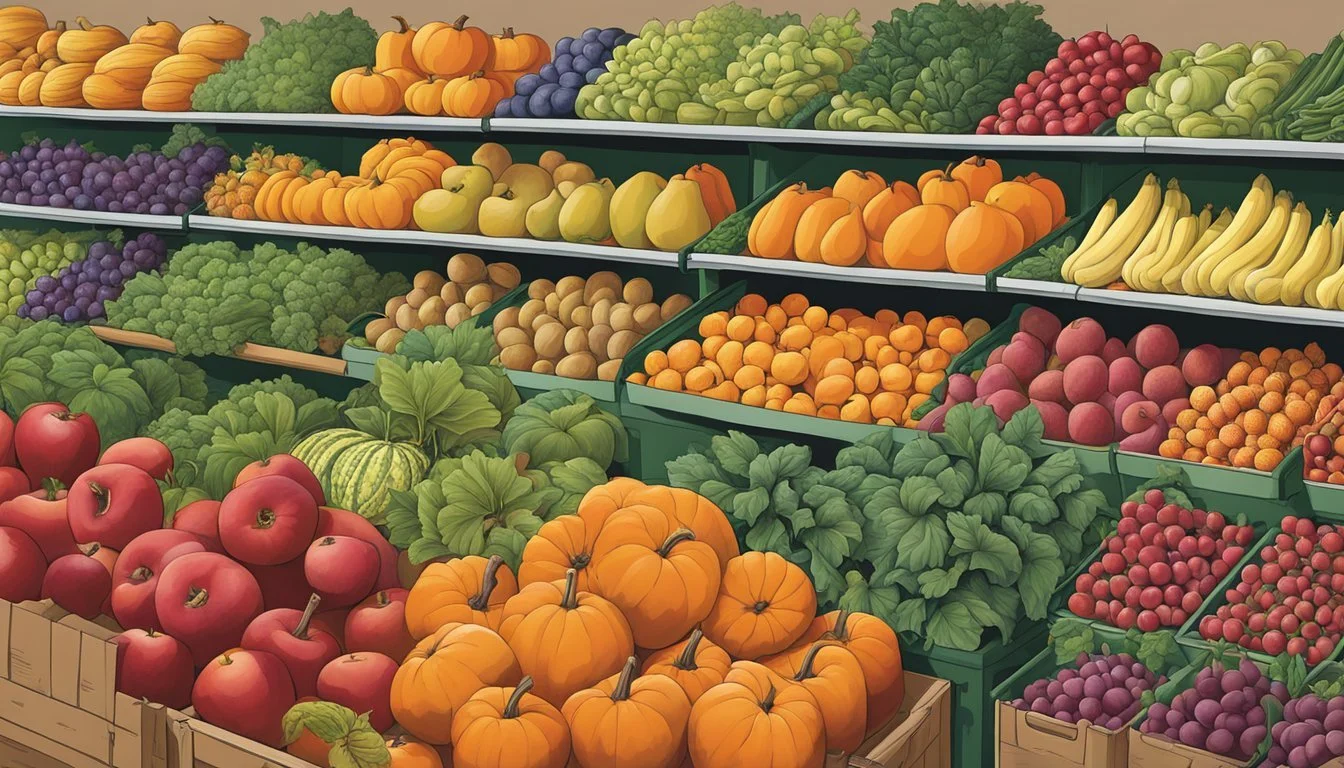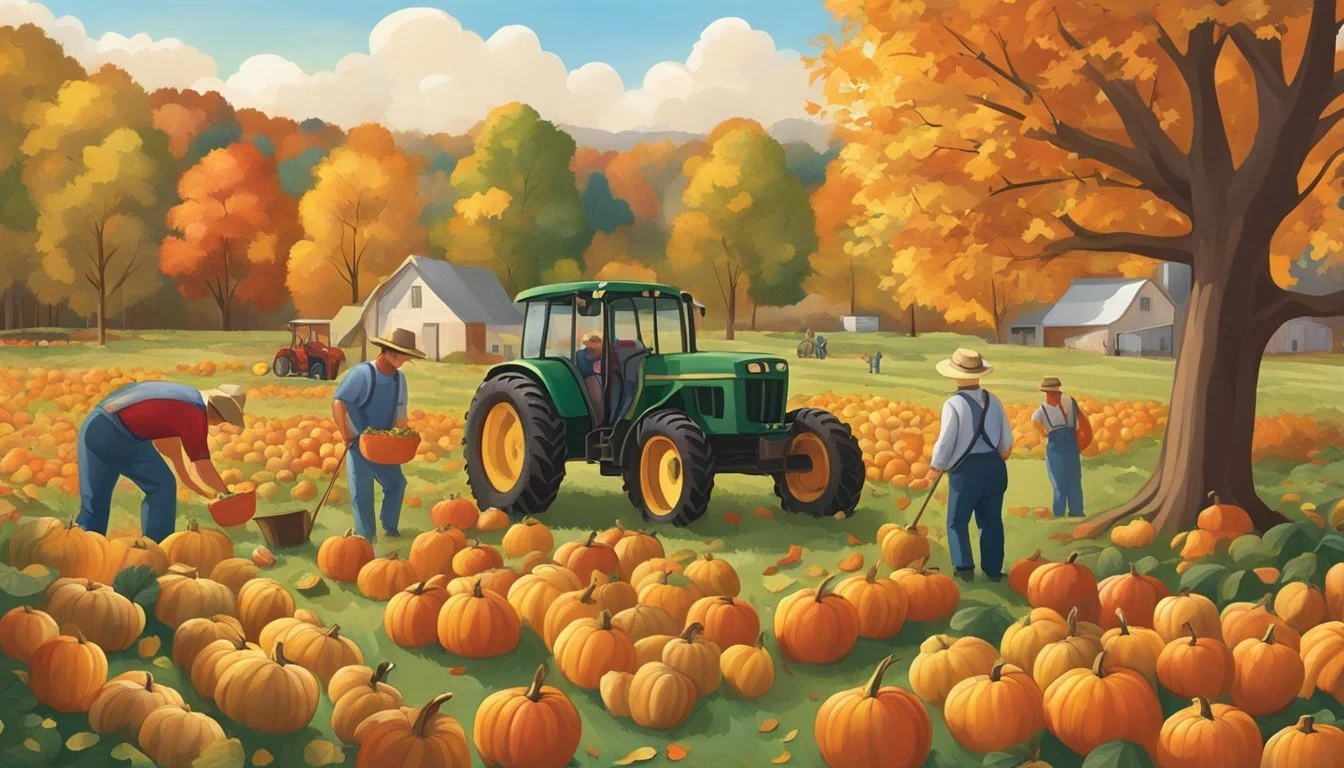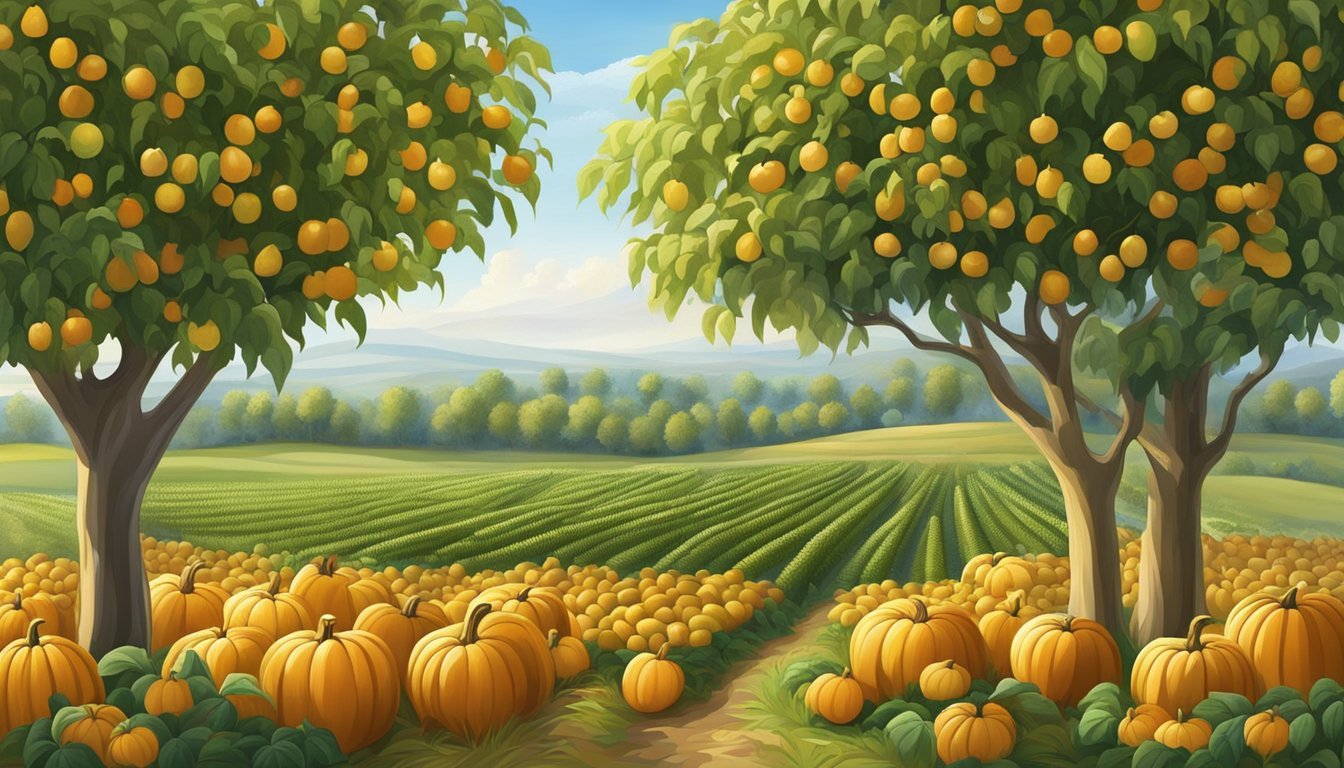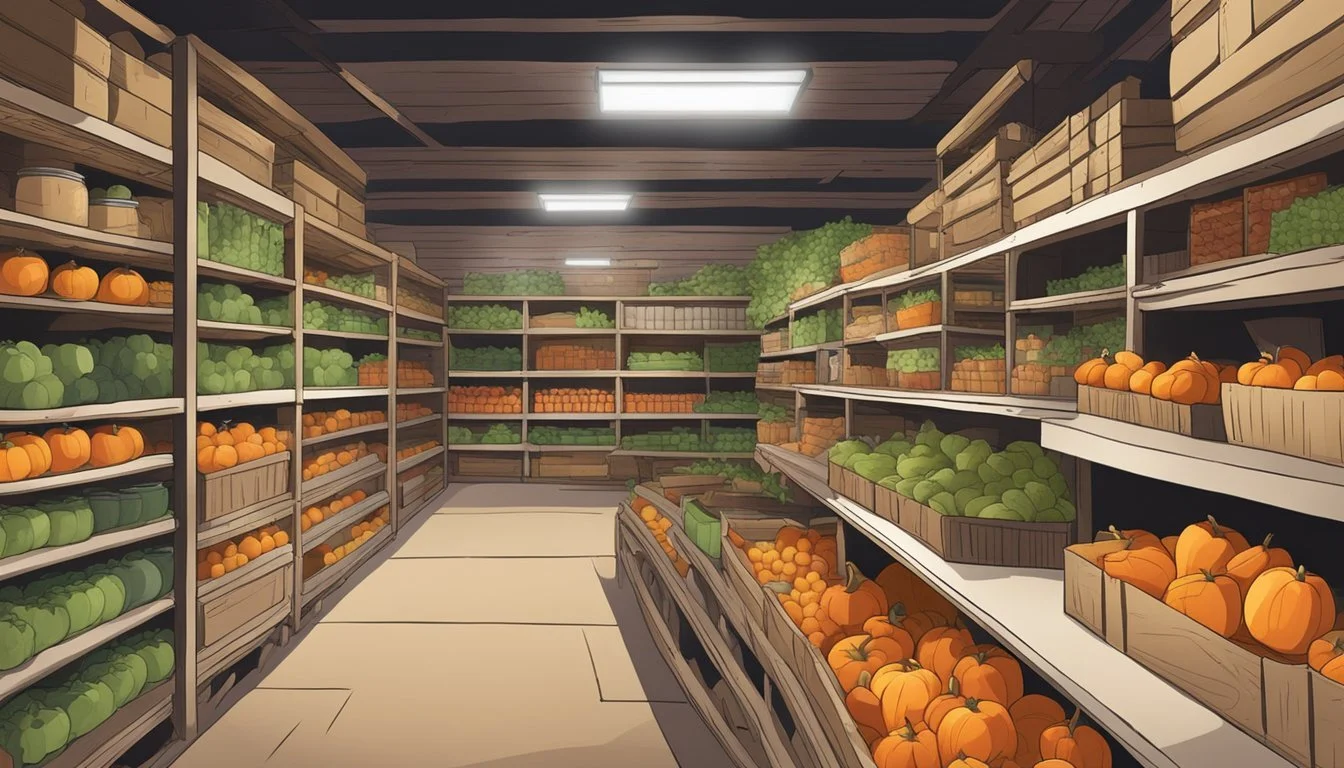Ohio Seasonal Fruit & Vegetables in November
Your Guide to Fresh Produce
This Article is Part of our Ohio Seasonal Fruit & Veg Calendar
In Ohio, the onset of November brings a shift in the variety of fresh produce available to consumers. As the autumn season lingers, the state's harvest aligns with the heartier preferences typical of cooler weather. During this month, Ohioans have the opportunity to enjoy a range of fruits (What wine goes well with fruit?) and vegetables that not only stand up to the dropping temperatures but also contribute to a seasonally inspired palette of flavors.
Fruits, although less abundant than in the summer months, still offer a selection that includes apples and pears—which remain crisp and delicious thanks to modern storage techniques. Simultaneously, vegetables take center stage with an array of robust options. Root vegetables like sweet potatoes and beets (how long do beets last?), along with various types of winter squash such as acorn, butternut, and kabocha, become staples in local cuisine.
Ohio's November harvest also extends to include leafy greens like kale (What wine goes well with kale?) and collard greens (how long do collard greens last?), which can tolerate the cooler temperatures. These vegetables, alongside late fall harvests of pumpkins and a continued supply of tomatoes, ensure that Ohio residents can find fresh, nutritious produce even as the winter season approaches.
Overview of Ohio's Seasonal Produce in November
November in Ohio marks a transitional period where the fall harvest meets the beginning of winter, resulting in a unique blend that defines the state's seasonal offerings. Farmers and consumers alike witness a shift in availability as the late autumn produce fills the markets before winter sets in.
Fall Produce: The tail-end of the fall harvest brings robust flavors. Root vegetables like beets and parsnips thrive in this cooler month, storing well into the coming winter.
Winter Preparations: While November marks the concluding chapter of autumn, preparations for Ohio's winter produce begin. Hardy vegetables such as kale, cabbage, and Brussels sprouts (how long do brussels sprouts last?) are typically in good supply, exhibiting a resilience to the state's changing temperatures.
Fruit Availability: Orchard fruits dwindle in November, but some varieties of apples persist and offer Ohioans fresh, crisp flavors that are emblematic of the season.
Season Monthly Highlights Late Fall Beets, Parsnips, Turnips Transition Kale, Cabbage, Brussels Sprouts Fruit Late-season Apples
While the fields may be readying for dormancy, consumers can still enjoy a variety of produce that encapsulates the essence of Ohio's agricultural landscape. As the state moves through November, these selections speak to the hardiness and diversity of crops that Ohio's farmers manage and maintain.
Fruits and Vegetables in Season
In November, Ohio offers a robust selection of seasonal fruits and vegetables that promise freshness and rich flavors. Local markets brim with fall produce ideal for hearty meals and holiday feasts.
Fruits Available in November
In Ohio's November chill, the fruit offerings are limited but hearty:
Apples: Varieties like Fuji, Jonagold, and Granny Smith are ripe for the picking.
Pears: Look for locally grown, crisp Bosc and Anjou pears during this time.
Fresh fruits like apples and pears not only retain their flavor but also offer versatility for various recipes, from pies to ciders.
Vegetables Available in November
November's cool temperatures are suitable for harvesting a variety of vitamin-rich vegetables:
Pumpkins: Perfect for pies, soups, or roasting.
Squash: Varieties such as butternut and acorn squash are abundant.
Kale: Hardy and flavorful, kale is a staple green in November.
Beets: These root vegetables are sweet and deep in color, great for roasting or salads.
Carrots: Expect crisp texture and sweet flavors from these vibrant roots.
Brussels Sprouts: These can be found on the stalk, offering a fresh taste often milder than sprouts found at other times of the year.
These vegetables lend themselves well to comforting dishes that warm the heart and home during the cooler days of late autumn.
Harvesting and Availability
In Ohio, November marks the transition towards the end of the harvest season. Certain hardy crops are still being gathered while others are reaching consumers via different storage methods.
Harvest Periods for November Crops
Corn: Typically harvested before November, but some late varieties may still be available early in the month.
Turnips: These root vegetables are resilient and often harvested throughout November.
Winter Squash: Harvesting of varieties such as butternut and acorn squash generally concludes in November.
Chard: This leafy vegetable can endure cold weather and can be harvested into November.
Availability of Produce in Grocery Stores
Corn: Mostly available from storage as fresh harvests are rare.
Turnips: Fresh turnips are commonly found, due to their ability to withstand frost.
Winter Squash: Abundant, since it stores well and is a staple for fall and winter months.
Chard: Sometimes limited, but potentially available fresh due to its cold tolerance.
Local grocery stores may extend the availability of these products beyond their harvest dates through modern storage techniques and hydroponic farming methods, ensuring that customers have access to fresh fruits and vegetables throughout the season.
Culinary Uses and Recipes
In November, Ohio's seasonal produce offers a wealth of flavors ideal for creating warming dishes and preserves. This bounty inspires a variety of recipes, from sweet fruit jams to savory vegetable dishes.
Seasonal Fruit Recipes
Cranberry Jam: Cranberries, with their tart flavor, make an excellent jam. A simple cranberry jam can be prepared by simmering cranberries with sugar and water until the berries burst and the mixture thickens.
Ingredients: Fresh cranberries, sugar, water.
Use: Spread on toast, swirl into yogurt, or pair with roasted meats (What wine goes well with roasted meats?).
Apple Salsa: Apples, crisp and lightly sweet, can be diced and mixed with onions, jalapenos, cilantro, and lime juice to create a fresh salsa.
Ingredients: Apples, onions, jalapenos, cilantro, lime juice.
Use: A refreshing accompaniment to grilled chicken or pork.
Seasonal Vegetable Dishes
Squash Soup: Squashes are versatile and can be roasted and pureed into a creamy soup. They offer a mildly sweet and nutty flavor, perfect for a comforting bowl on chilly days.
Ingredients: Squash, onions, garlic, broth, cream.
Use: Serve as a starter or a main dish with crusty bread.
Braised Cabbage: Cabbage, with its peppery flavor, can be braised in stock with apples or pears, adding a sweet contrast to the dish.
Ingredients: Cabbage, apples or pears, stock, seasonings.
Use: As a side dish for roasted meats or incorporated into hearty stews.
Agricultural Practices in Ohio
Ohio’s diverse agriculture is sustained through sophisticated farming practices and the support of the Ohio Farm Bureau. The state's commitment to modern storage techniques helps in extending the availability of fresh produce.
Farming and Growing Conditions
Ohio is characterized by its varied growing conditions, which are conducive to a wide range of crops. The climate includes warm, humid summers and cold winters, creating a suitable environment for fruits and vegetables that thrive in such conditions. Strategic use of modern storage techniques further ensures that crops can be preserved beyond their typical harvest times.
Farmers in Ohio diligently monitor soil health and weather patterns to maximize yield and quality. They harness a mix of traditional and innovative farming techniques to adapt to the ever-changing environmental conditions. The deployment of technology in the fields aids in efficient resource management and contributes to sustainable agricultural practices.
Role of Ohio Farm Bureau
The Ohio Farm Bureau plays a crucial role in supporting the state's agriculture. This organization offers educational resources, advocacy, and community support to Ohio’s farmers. It helps in disseminating best practices for farming and the use of modern storage techniques.
Key functions of the Ohio Farm Bureau include:
Advocating for policies that benefit the agricultural sector
Providing educational programs to advance the knowledge of farmers
Promoting the use of advanced storage and preservation techniques
Offering leadership development for the future of Ohio’s agricultural community
With these efforts, the Ohio Farm Bureau ensures that farmers have the tools they need to produce bountiful crops year-round, while also aiding in the distribution and marketing of Ohio-grown produce.
Storage and Preservation
In Ohio, November marks the end of the harvest season for many fruits and vegetables. Effective storage and preservation methods are essential to extend the availability of these food items through the winter.
Modern Storage Techniques
Modern storage techniques rely on controlling the environment in which fruits and vegetables are kept to slow down spoilage and maintain quality. Controlled atmosphere storage is a key method where oxygen, carbon dioxide, and humidity levels are precisely regulated. Farmers often employ cold storage facilities to keep produce like apples, which are harvested in fall, fresh well into the winter months. For items such as winter squash, storage in a cool, dry place can extend their shelf life significantly.
Home Preservation Methods
Home preservation allows individuals to extend the enjoyment of Ohio's produce beyond the harvest. Canning is a popular method for preserving fruits and vegetables; products like jam and salsa can be made during the harvest and enjoyed throughout the year. Freezing is another simple technique that can effectively preserve the integrity of produce, such as sweet corn and berries. Proper blanching prior to freezing can help maintain color, texture, and nutritional value. Residents often use these methods to keep a taste of November's harvest on the table until the next season.
Understanding Seasonal Eating
Seasonal eating involves consuming fruits and vegetables that are harvested at the peak of their freshness during the year. It brings a variety of benefits to both consumers and the local economy, particularly when practiced within a specific state such as Ohio.
Benefits of Eating Seasonally
Flavor and Nutrition: Eating seasonally ensures that one enjoys the optimal taste and nutritional benefits of produce. Fruits and vegetables harvested during their appropriate season possess a naturally richer flavor. For instance, in November, Ohioans often relish fresh apples that are not only crisp but also packed with vitamins due to being picked at the right time.
Diverse Diet: By following a seasonal eating pattern, consumers are encouraged to try a broader range of produce, including those that may not be available year-round. This can lead to a more diverse and balanced diet.
Impact on Local Economy
Supports Local Farmers and Agriculture: Buying seasonal produce directly influences the state's agriculture by supporting local farmers. When consumers choose to buy what is in season in Ohio, they are investing in the local economy and promoting sustainability within the state's agricultural sector.
Reduces Transportation Costs and Environmental Impact: Seasonal eating can also lessen the environmental impact of food transport. Consuming in-season fruits and vegetables reduces the need for long-distance shipping, which in turn decreases the carbon footprint associated with transportation.









